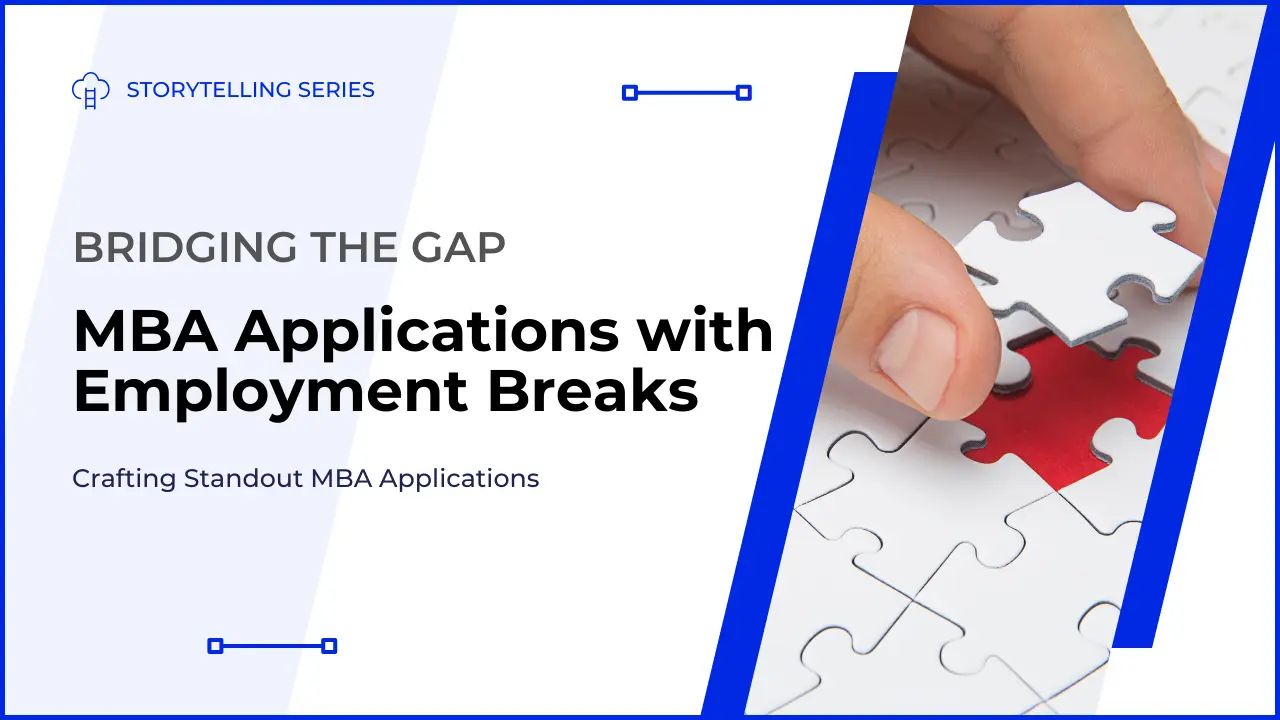Ever wondered if that gap in your resume is the thing standing between you and your dream MBA?
Relax, you’re not alone. And guess what? That gap might just be your secret weapon.
Yup, you read that right. In today’s world, employment gaps are as common as a traffic jam in one of the Indian metro cities. Whether you took time off to backpack through Europe, binge-watch Netflix, or deal with life’s unpredictable ups and downs, many top MBA students have been in your shoes.
Ready to turn that gap into the golden ticket for your MBA dreams? Let’s do this!
- Normalizing Employment Gaps in MBA Applications
- Types of Employment Gaps and How to Frame Them Positively
- Crafting MBA Applications with Employment Breaks
- Productive Activities to Fill Employment Gaps
- Choosing the Right Recommenders with Employment Gaps
- Interview Strategies: Confidently Discussing Your Employment Gap
- Post-MBA Job Search Strategies for Applicants with Past Gaps
1. Introduction: Normalizing Employment Gaps in MBA Applications
First things first, let’s get one thing straight: Employment gaps? Totally normal. Like, more common than chai breaks in a startup office.
Here’s the deal: Adcoms (that’s Admissions Committees, for the uninitiated) aren’t looking to push you to a corner. They know life happens. What they care about is how you’ve handled the gap and what you’ve learned from it.
So here’s your mantra:
- Employment gaps aren’t bad.
- How you spin the story matters more than the gap itself.
- Gaps can give you some pretty awesome life lessons.
Ready to make that gap work in your favor? Let’s go!
2. Types of Employment Gaps and How to Frame Them Positively
Not all gaps are created equal. But don’t worry, we’ve got a strategy for every kind.
Voluntary Breaks:
- Travel: Did you spend six months backpacking through the Himalayas? Talk about how it gave you a global perspective, taught you new languages, or made you the guru of cross-cultural communication.
Example: “After working in a high-pressure corporate job for five years, I decided to take a six-month break to backpack through the Himalayas. During this time, I immersed myself in diverse cultures, learned basic Nepali and Tibetan, and gained a deep understanding of cross-cultural communication. This experience broadened my global perspective and has made me more empathetic and adaptable, qualities that will enhance my contributions in an international MBA environment.”
- Family Care: Managed your home like a pro? Whether it was looking after kids or elderly parents, highlight those killer multitasking and management skills you honed.
Example: “When my mother was diagnosed with a chronic illness, I chose to take a year off to care for her full-time. Managing her medical appointments, coordinating with healthcare providers, and balancing household responsibilities taught me invaluable multitasking and management skills. This experience also strengthened my emotional resilience and reinforced my belief in the importance of work-life balance, which I plan to uphold in my future leadership roles.”
- Personal Projects: Whether you started a blog or a side hustle, this is your chance to show off your creativity, initiative, and any cool outcomes you achieved.
Example: “During a planned break from my career, I launched a blog focused on sustainable living, which quickly gained a following of 10,000 readers. Through this project, I honed my skills in content creation, digital marketing, and community building. Additionally, I collaborated with eco-friendly brands to run campaigns, showcasing my ability to lead initiatives and drive results. This experience fueled my passion for entrepreneurship, which I aim to further develop during my MBA.”
Involuntary Breaks:
- Layoffs: It’s not the end of the world. Spin it as a tale of resilience and adaptability. Bonus points if you kept busy with freelance gigs or volunteer work during this time.
Example: “After a sudden company-wide layoff at my previous job, I found myself at a crossroads. Instead of letting this setback define me, I used this time to take on freelance consulting gigs. I worked with small businesses to streamline their operations and improve profitability, allowing me to stay sharp and expand my skill set. This period of uncertainty ultimately strengthened my problem-solving abilities and reinforced my commitment to pursuing an MBA to secure my long-term career goals.”
- Health Issues: Focus on what you learned, how you grew, and how it made you even more determined to succeed.
Example: “A few years ago, I faced a serious health issue that required me to take a break from my career. During this challenging time, I focused on personal growth and reflection. I delved into mindfulness practices, which helped me develop a greater sense of self-awareness and emotional intelligence. As I recovered, I also completed online courses in project management and data analysis, turning adversity into an opportunity for professional development. This experience made me more determined and resilient, qualities that I will bring to my MBA journey and future career.”
See? That gap is starting to look a lot more like an opportunity, isn’t it?
Start Your MBA Journey with a Free Profile Evaluation Today
Start Your MBA Journey with a Free Profile Evaluation Today
3. Crafting MBA Applications with Employment Breaks
Time to flip the script and make that gap your hero moment. Here’s how:
Resume Techniques:
- Use years instead of months to downplay short gaps (who needs to know the exact timeline, anyway?).
- Include any non-traditional experiences during your gap (like that time you ran a charity marathon or became a sourdough expert).
- Consider a functional or combination resume format to highlight your skills over your work chronology. No one said you had to play by the rules.
Essay Approaches:
- Got an optional essay? Use it to drop a quick explanation of your gap and how it made you stronger, faster, and ready to conquer the MBA world.
- In your main essays, sneak in the lessons learned or skills gained during your gap. Subtle, but effective.
- Connect your gap to your future goals and your burning desire for that MBA. Make it all part of the master plan.
Want to do a deep dive into how storytelling can help set your application apart? Read our complete guide here: MBA Essay Writing: A Complete Guide to Storytelling Techniques
4. Productive Activities to Fill Employment Gaps
Still in the gap? No worries! Here’s how to fill that time like a boss:
- Freelance or Consulting Work: Shows you’re proactive and keeps those skills razor-sharp.
Example: “During a six-month career break, I took on freelance consulting projects to help small businesses optimize their operations. One notable project involved streamlining the supply chain for a local retailer, which resulted in a 20% reduction in costs and a 15% increase in customer satisfaction. This experience not only kept my skills sharp but also enhanced my ability to work independently and deliver impactful results under tight deadlines.”
- Volunteer Work: Gives you community creds and might even land you some leadership experience.
Example: “While taking time off between jobs, I volunteered with a local NGO that provides educational resources to underprivileged children. I led a team of volunteers in organizing a series of workshops on digital literacy, which reached over 200 students. This role allowed me to develop my leadership skills, and seeing the direct impact of our efforts on the community was incredibly rewarding. It also reinforced my commitment to social responsibility, a value I plan to carry into my MBA and future career.”
- Online Courses or Certifications: Shows you’re all about lifelong learning.
Example: “During a gap year, I completed several online courses in data science and earned a certification in Python programming. These courses not only satisfied my passion for lifelong learning but also equipped me with skills that I applied in a personal project analyzing startup success factors. This continuous learning mindset is something I intend to bring to my MBA studies and beyond, as I believe in constantly evolving to stay relevant in today’s fast-paced business environment.”
- Starting a Small Business or Side Project: Display that entrepreneurial spirit (even if it’s just a simple online shop).
Example: “During my career break, I started a small online business selling handcrafted jewelry. From designing the products to handling the marketing, logistics, and customer service, I gained firsthand experience in running a business. Although it started as a side project, it grew into a profitable venture with a loyal customer base. This experience ignited my entrepreneurial spirit and gave me practical insights into business operations, which I am eager to expand upon during my MBA.”
- Learning a New Language: Shows you’re globally minded and dedicated to self-improvement (plus, it’s just plain cool).
Example: “After relocating to Spain for a year, I dedicated myself to learning Spanish, achieving fluency in both spoken and written communication. This not only helped me integrate into the local culture but also deepened my appreciation for global perspectives. Learning a new language from scratch was challenging, but it honed my perseverance and adaptability. These qualities, along with my global mindset, will be invaluable as I pursue an MBA with a focus on international business.”
See? Your gap is looking more and more like a win.
Start Your MBA Journey with a Free Profile Evaluation Today
Start Your MBA Journey with a Free Profile Evaluation Today
5. Choosing the Right Recommenders with Employment Gaps
Picking recommenders when you’ve got a gap can be tricky, but it’s not impossible. Here’s your game plan:
- Former supervisors or colleagues (even if they’re not your most recent).
- Clients from freelance work who think you’re truly awesome.
- Supervisors from volunteer positions who can vouch for your dedication and skills.
- Mentors or advisors who have seen you grow and can talk up your potential.
And don’t forget to brief your recommenders on how you’re framing your gap. It’s very important that you’re all telling the same story. Teamwork makes the dream work, right?
6. Interview Strategies: Confidently Discussing Your Employment Gap
You’ve got the interview. Now it’s time to own your gap like a boss:
- Be honest and straightforward about why you had a gap.
- Focus on what you learned or the skills you developed during this time.
- Connect your gap to your MBA motivation and future goals.
- Practice your explanation until you can deliver it with confidence and ease.
Start Your MBA Journey with a Free Profile Evaluation Today
Start Your MBA Journey with a Free Profile Evaluation Today
7. Post-MBA Job Search Strategies for Applicants with Past Gaps
Landed that MBA spot? Congrats! Now let’s talk about your post-MBA game plan:
- Use your MBA to rebrand yourself and focus on where you’re headed, not where you’ve been.
- Leverage those unique experiences from your gap to stand out in the job market. You’ve got a story no one else has.
- Network like crazy, using your gap as a conversation starter. People love a good comeback story.
- Don’t skip those MBA internships. They’re your golden ticket to gaining fresh, relevant experience.
- Be ready to discuss your gap positively in interviews. It’s all about the growth, baby!
Conclusion
Let’s get one thing straight: An employment gap doesn’t have to be a roadblock. In fact, it might just be the thing that sets you apart.
By framing your gap as a period of growth and learning, you can turn it into a strength in your MBA application. Remember, B-schools are looking for diverse experiences and perspectives. Your gap could be the unique twist that makes your story unforgettable.
So, embrace your journey—gaps and all. It’s what makes you, well, YOU. And that’s exactly what top MBA programs are looking for.
There you have it! Your employment gap just went from potential problem to MBA superpower. Now go out there and crush that application!





0 Comments